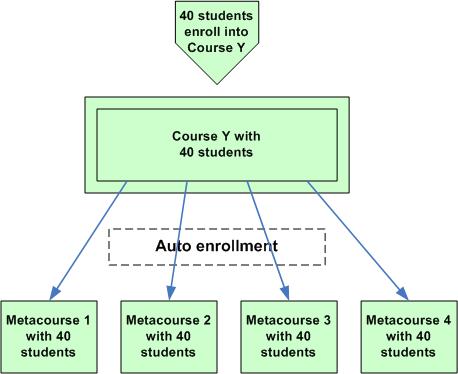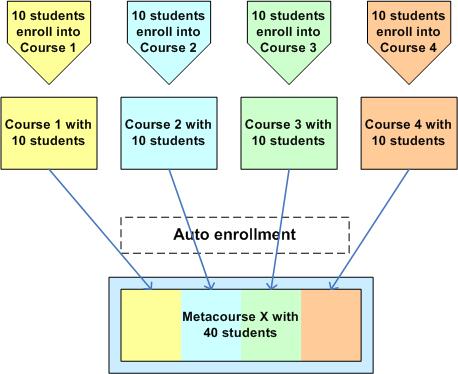Metacourses can be used in many ways to fill some special needs around student enrolment. Here are some examples scenarios that may help you to understand how they work.
Yearly intake
This example uses LDAP to enrol each year's intake of students onto that year's 'Course Noticeboard'. Then by making each of the Modules meta courses, and assigning their 'child' as that year's 'Course Noticeboard', the learners are automatically enrolled on all of the necessary module
Foundation Degree (2009 intake) [course category] Course 2009 Noticeboard (uses LDAP to enrol 2009 students) Year 1 [course category]
- Module 1 (Metacourse linked to 2009 Noticeboard_
- Module 2 (Metacourse linked to 2009 Noticeboard_
- Module 3 (Metacourse linked to 2009 Noticeboard_
- etc.
Foundation Degree (2010 intake) [course category] Course 2010 Noticeboard (uses LDAP to enrol 2010 students) Year 1 [course category] Module 1 (Metacourse linked to 2010 Noticeboard_ Module 2 (Metacourse linked to 2010 Noticeboard_ Module 3 (Metacourse linked to 2010 Noticeboard_
Jerome Di Pietro in Teaching Strategies forum
1 course that sends its enrolments to 4 other courses
Meta courses 1-4 each have created a "child" link to Y which is a normal course. Students enrolling on Course Y are automatically enrolled in Meta courses 1–4.
For example: this would be used, when all five courses are intended to have exactly the same students.
1 course that gets its enrolment from 4 other courses
X is a meta course and Courses 1, 2, 3, 4 can be normal courses with standard student enrolments. These courses can contain resources, and activities that are specific to those courses, but they may also only contain enrolments. Students enrolling in Courses 1 or 2, or 3 or 4, are automatically enrolled onto Meta course X when the course is associated as a child course to Meta course X. The meta course is dependent upon its enrolments from each of the non-meta courses, the child courses.
For example, a math teacher has 2 algebra and 2 geometry courses and wants a "home room" to place things of interest for all of their students. The teacher creates a meta course called "Teacher's home room" and links the algebra and geometry courses as the "child" courses.
"Merged course" / 1 course that consolidates enrollment from multiple other courses
For a course with multiple sections - that is, a course where the same material is taught to students enrolled in several separate sections/courses - it is sometimes desirable to create a "merged course" that is used by students across all sections. This assumes that there is no section-specific information.
To create a "merged course," select one existing course/section that will become the merged metacourse. In that course:
- In the Settings module, navigate to Course administration -> Users -> Enrollment methods.
- Use the Add method drop-down menu to select Course meta link.
- Use the Link course drop-down menu to choose one of the other sections/courses you wish to merge into the metacourse.
- Repeat the preceding steps as necessary for additional sections/courses.
To make it clear which course is the merged metacourse, go to that course and:
- In the Settings module, navigate to Course administration -> Edit settings.
- Change the Course full name appropriately (consider "[Course Number] - [Course Name] - [Course Date]" e.g. "CSSE101 - Introduction to Computer Science - 201210")
- Click Save changes.
To hide the unused sections/courses, go to each course and:
- In the Settings module, navigate to Course administration -> Edit settings.
- Use the Availability drop-down menu to select This course is not available for students.
- Click Save changes.
Meta course(s) used as libraries
One or more meta courses are used as a library of resources and activities.
For example, the English department has collected material useful in writing papers, these are set up as meta courses, with links to their regular courses. Teachers can direct or embed a link to a specific reference about citations, or how to select a topic for a paper or suggested reading compiled by students. Thus an English 101 course should be one of the links in the "Writing Papers" meta course. This Meta course holds a resource called "Citations made easy", a Lesson "Select a topic" and a Wiki or database called "Suggested readings from classmates".
Expanding the library concept
I teach 4 sections of the same course and use a metacourse as the repository for materials used in the 4 sections. What I did was create the resource in the metacourse and then link that resource to the sections. For instance, I created a web page in the metacourse that included course notes. These course notes are in the form of 17 pdf files. The web page has links to the 17 files that were uploaded to the metacourse. Thus, the files and the web page that students will use to get to the files all exist in the metacourse.
Next I created a link to the web page in my normal courses. To do this I had to execute the web page in the metacourse and copy the address from my browser into the link I created in the normal course.
When the student is in the normal section course, they simply click on the link and the web page in the metacourse appears. The only minor problem is that the student navigation might leave them in the metacourse instead of the normal section course. To lessen this effect, I always launch links to the metacourse in a new window. Normally students understand that they need to close the popup window when they are finished with it.
There are several advantages to using metacourses in this way. First, it saves having to upload the same materials more than once. I can change a file in the metacourse and know that it is changed in all section courses. Second, it saves storage space. Third, it provides the possibility of developing learning objects or mini courses that can be quickly linked to create a new course. Finally, it would allows several teachers to pick and choose what materials to include in their section courses.
One hint, I put all activities (assignments, forums, journals, etc.) in the child course, not in the metacourse. This keeps grading segregated and allows me to adjust assignments for a particular section (child).
Harold Kime Teaching strategies forum thread.
Common department area
Here is how we use metacourses for our district. Lets take a math teacher for example who teaches algebra 1, algebra 2 and geometry. This teacher wants a space (Moodle course) for each of their main subject areas. But they also want a generic space where they can post things for all of the students in all of their classes. This is where a meta course comes into play.
We create a Moodle course for algebra 1, another course for algebra 2 and a 3rd course for geometry. Now we enroll all of the appropriate students into each of these courses. Next we create a meta course and to the meta course we assign the first three courses created. Now by default, all of the students in the first three courses are automatically enrolled in the meta course. Now anything posted in the metacourse is available to all the students in the other three courses.
Randy Orwin Teaching strategies forum thread.
A Diploma course sends its enrolment to meta courses
A Diploma program involves courses D1, D2, D3, and D4. In this case, you would create a "Diploma" course as a normal course (non-meta course). You would then designate programs D1 through D4 as meta courses and each would show the Diploma course as the "child" course. When a student enrolls in "Diploma", he or she will be automatically enrolled in courses D1 through D4.
Core subjects with fees based upon course groupings
You have 3 course subjects and want to offer them for sale in different packages. The meta courses will contain your subjects. A normal (non-Meta course) course will be the gateways to the meta course(s). Course 1 is your gold package. Meta course A, Meta course B and Meta course C all link to Course 1. The silver package is Course 2. Meta courses A and B link to Course 2. You have also set up individual courses that have a link from a specific Meta Course to them. Thus you can offer and charge for each meta course separately or in some combination.
One course, different student fees
You have one "Wizbang" course but want to charge a different rate based upon the type of user. The "Wizbang" meta course is the one that holds the content. You create a courses for "Wizbang for Large Corporation users" and "Wizbang for Small Business users". The Wizbang meta course is linked to "Introduction to Wizbang for Large Corporation users" and "Introduction to Wizbang for Small Business users" courses. You can charge a different fee for the non-meta courses, maybe brand or put some unique material in each "Introduction" course but the students will be able to take the same "Wizbang" course.
Two courses, combined teaching space
We have automatic enrolment into Moodle using a custom enrolment plugin. We often have two or more courses that are taught together by the same teacher, in the same classroom with the same lectures. We create a metacourse for both courses and add the two individual courses as child courses.
Student Support Space for degree programme
We have a programme which is fully online. We have created a metacourse as a support space which includes information for the programme, specific forums for groups of students (using groups & groupings) and Social Forums to allow students to interact with each other.

